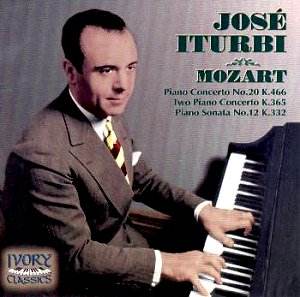It’s certainly unfair that José Iturbi’s name
has become so little known. Partly this must stem from his exceptional
popularity – he had a couple of million-selling RCA discs – but also
from the direction his career took when he assumed the conductorship
of the Rochester Philharmonic. His film stardom was pretty much a nail
in the coffin of his connoisseur reputation. In this all-Mozart disc
that restores Iturbi’s 1937-40 RCA Victors to the catalogue we have
a strong insight into his playing of the central repertoire, as distinct,
say, from his perhaps more celebrated Albéniz.
Born in Valencia in 1895 Iturbi was, as were many Spanish
pianists, trained in Paris. He earned a precarious living in cafes and
taught elsewhere in Switzerland before accepting a position at the Conservatory
in Geneva. Despite increasing success as a concert soloist – he made
his American debut for instance playing the Beethoven G minor accompanied
by Stokowski and the Philadelphia – his sights were set on a conductor’s
career. He guest conducted widely before, in the 1936-37 season, he
was appointed Rochester’s conductor and his enormous popularity really
dates from the period of his numerous MGM films – rather garish and
ghastly if memory serves right.
Ivory Classics’ disc shows that he had very distinct
gifts as a Mozartian – unmannered, direct, plain-speaking, imperturbable,
technically eloquent and fully capable of withstanding any technical
or expressive problem. The D minor Concerto – which like the Double
Concerto he directs from the keyboard – elicits from Iturbi a measured
and effortless musicality. He also has a deal of style and manages to
elucidate the orchestral string figuration with care and clarity. The
answering violin phrases are very well brought out and when it comes
to his pianism his cadenza (Beethoven’s) is notably successful. There
are maybe some overripe string phrases in the Romanza but we
can certainly forgive him this indulgence for the affectionate simplicity
he brings to the music. What I did lack though from time to time was
a greater sense of depth. For all the elegance and lyrical impress –
undeniable – there was some lack of verticality in his response. No
arguments about the finale however – fluent and fleet and decisive.
The Double Concerto with his sister Amparo is a strong one though hardly
one preferable to the Schnabels’ almost contemporaneous recording. Its
virtues are splendid passagework, sympathetic collaboration, very fine
cadenzas from Iturbi himself and a buoyant musicality. The central work
is the F major sonata K332. Clearly he was a significant Mozartian and
this performance signals his abundant talent. Much admired though the
recording is however I find the root of the Iturbi problem as ultimately
one of a lack of projection of the inner life of the Adagio.
For all his clarity and for all his self-evident finesse there is sometimes
a frustrating lack of deeper exploration. Still these limitations –
if such they are - are no bar to appreciation of his other strikingly
persuasive strengths and this Ivory Classics transfer presents these
recordings with notable success, indeed with a clarity that befits Iturbi’s
own.
Jonathan Woolf
